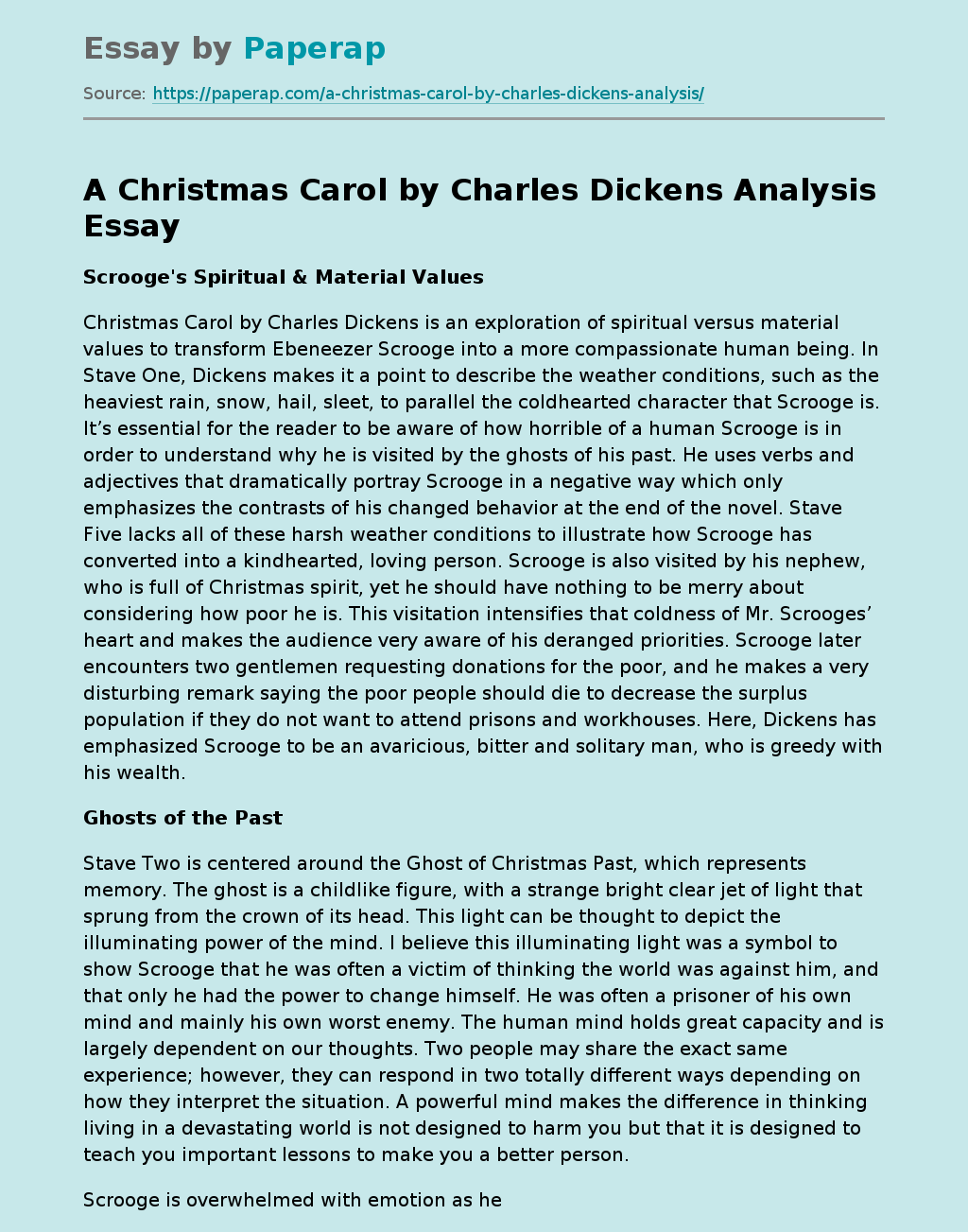A Christmas Carol by Charles Dickens Analysis
Scrooge’s Spiritual & Material Values
Christmas Carol by Charles Dickens is an exploration of spiritual versus material values to transform Ebeneezer Scrooge into a more compassionate human being. In Stave One, Dickens makes it a point to describe the weather conditions, such as the heaviest rain, snow, hail, sleet, to parallel the coldhearted character that Scrooge is. It’s essential for the reader to be aware of how horrible of a human Scrooge is in order to understand why he is visited by the ghosts of his past.
He uses verbs and adjectives that dramatically portray Scrooge in a negative way which only emphasizes the contrasts of his changed behavior at the end of the novel. Stave Five lacks all of these harsh weather conditions to illustrate how Scrooge has converted into a kindhearted, loving person. Scrooge is also visited by his nephew, who is full of Christmas spirit, yet he should have nothing to be merry about considering how poor he is.
This visitation intensifies that coldness of Mr. Scrooges’ heart and makes the audience very aware of his deranged priorities. Scrooge later encounters two gentlemen requesting donations for the poor, and he makes a very disturbing remark saying the poor people should die to decrease the surplus population if they do not want to attend prisons and workhouses. Here, Dickens has emphasized Scrooge to be an avaricious, bitter and solitary man, who is greedy with his wealth.
Ghosts of the Past
Stave Two is centered around the Ghost of Christmas Past, which represents memory.
The ghost is a childlike figure, with a strange bright clear jet of light that sprung from the crown of its head. This light can be thought to depict the illuminating power of the mind. I believe this illuminating light was a symbol to show Scrooge that he was often a victim of thinking the world was against him, and that only he had the power to change himself. He was often a prisoner of his own mind and mainly his own worst enemy. The human mind holds great capacity and is largely dependent on our thoughts. Two people may share the exact same experience; however, they can respond in two totally different ways depending on how they interpret the situation. A powerful mind makes the difference in thinking living in a devastating world is not designed to harm you but that it is designed to teach you important lessons to make you a better person.
Scrooge is overwhelmed with emotion as he visits memories and scenes of his childhood. This dialog makes us aware of how the past affects our present life and future. Unintentionally, we are always held captive to mistakes we have made, unhealthy relationships, painful confrontations, and trauma from our childhood. However, if we reflect inward and look to uncover the emotions we are feeling, we can begin to understand what drives our current life patterns. Although Scrooge was submerged with uncomfortable feelings as he looked deep into his past, he was freed from all emotional anchors as he allowed himself to experience joy and happiness from these experiences.
The second of the three spirits to visit Scrooge is the Ghost of Christmas Present. The ghost takes Scrooge to a number of Christmas gatherings. This emphasized Christmas as a merry, joyous day rather than a religious, holy day as it is often seen in today’s world. A Christmas Carol shows how possessing riches and wealth is not immoral if it is shared. Lavish parties and feasts can spread vacation cheer, and gives friends, family and the community a reason to get together. Here, Christmas is a time to share one’s riches and enjoy the company of loved ones. As their visit comes to a close, the Ghost takes Scrooge to a dilapidated area with starving children. As he looks upon these poor children, he instantly regrets his ignorant comment from earlier in the novel, “Are there no prisons? Are there no workhouses”. This scene opened my eyes to the sorrow and hardships other families and children face during Christmas.
Moral of the Story
Although we often get wrapped up in the business and celebrations of the holidays, it is necessary that we understand that for some, the Christmas spirit may be undermined by poverty, divorce, family tension, loss of loved ones, financial struggles, and mental illness. It opened my eyes to the fact that Christmas is a time of giving and sharing with those around us and it is not limited to just family and friends, but should be given equally to all.
A Christmas Carol by Charles Dickens Analysis. (2021, Nov 12). Retrieved from https://paperap.com/a-christmas-carol-by-charles-dickens-analysis/

